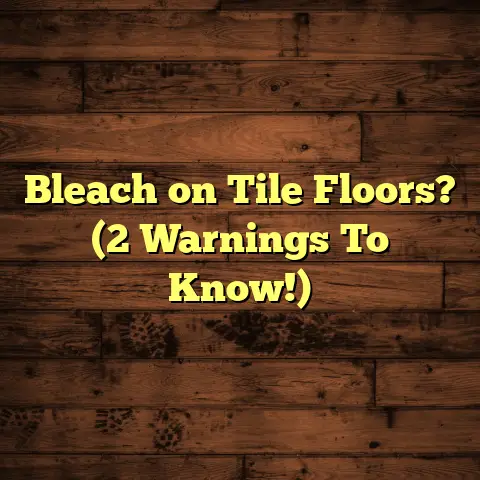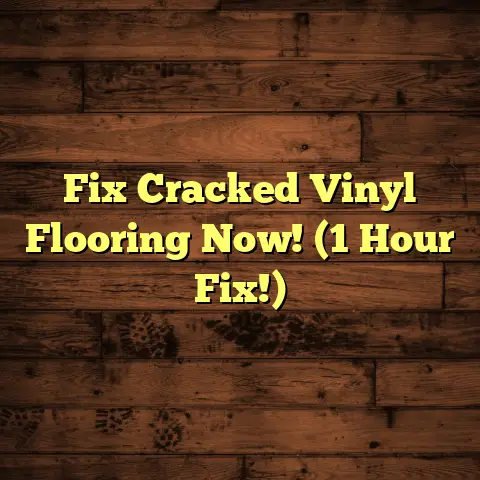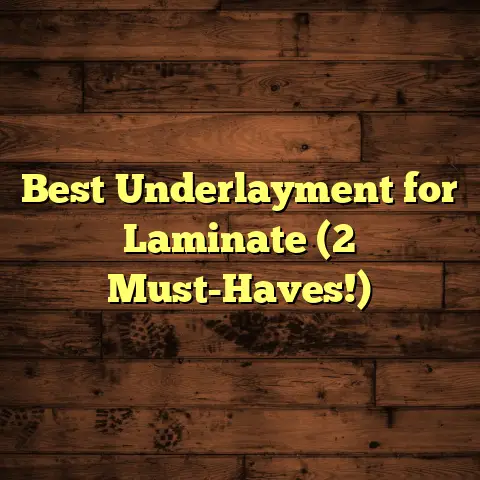Wood Over Wood? (9 Layering Nightmares!)
Modern aesthetics are all the rage, right?
Clean lines, natural materials, and that minimalist vibe – it’s what everyone seems to be craving.
And what’s a better way to achieve that than with gorgeous wood flooring?
It’s warm, versatile, and just plain timeless.
I’ve seen countless homeowners wanting to create that seamless, stylish interior.
Sometimes, that means layering different types of wood flooring.
Whether it’s for a fresh look or to cover up that old, worn-out surface, the idea’s tempting.
But before you grab that hammer and nails, let’s talk about the real deal.
The Appeal of Layering Wood Flooring
Okay, let’s be honest. Layering wood flooring sounds amazing.
Think about it: a brand new look without tearing up the old floor.
Saves time, right? And potentially reduces waste.
I mean, who doesn’t love a bit of sustainable design?
Reusing existing materials is a win-win.
Plus, you can get seriously creative with it.
Contrasting wood types, colors, patterns – the possibilities are endless!
It’s all about achieving that unique look that screams you.
But trust me, there’s more to it than meets the eye.
The Technical Challenges of Wood Over Wood Installations
Alright, let’s get down to the nitty-gritty.
Layering wood flooring isn’t just slapping planks on top of each other.
There are technical aspects that can make or break the whole project.
First, the subfloor. What’s it like?
Is it even? Is it solid? What’s the moisture level?
Then, you’ve got to consider the structural integrity of the existing floor.
Is it sturdy enough to handle another layer?
I can’t stress this enough: improper assessment is a recipe for disaster.
If you skip this step, you might be dealing with a whole new set of problems down the line.
And trust me, you don’t want that.
Nightmare #1: Uneven Surfaces
Let’s kick off the nightmares with a big one: uneven surfaces.
Imagine this: you’ve painstakingly installed your new wood flooring, and it looks…wavy.
The reason? Those sneaky imperfections in the original flooring transferred right through.
It’s not just unsightly; it can be downright hazardous.
Tripping hazards, anyone?
I’ve seen floors so uneven they looked like a rollercoaster.
And the worst part? It completely ruins the aesthetic and functionality of the space.
Real-Life Example:
I once worked on a project where the homeowner insisted on layering over an old, slightly warped hardwood floor.
We advised against it, but they were set on saving time and money.
The result? The new floor mirrored every dip and curve of the old one.
They ended up tearing it all out and starting from scratch.
A costly lesson learned.
Nightmare #2: Moisture Traps
Moisture. The silent enemy of wood flooring.
When you layer wood over wood, you’re essentially creating a potential moisture sandwich.
Moisture can get trapped between the layers, leading to a whole host of problems:
- Mold growth
- Warping
- Structural damage
According to the EPA, mold growth can start within 24-48 hours in moist conditions.
And trust me, mold isn’t something you want to mess with.
Expert Opinion:
“Moisture-related issues are incredibly common in layered flooring installations,” says flooring expert, Bob Vila. “Proper ventilation and moisture barriers are crucial.”
The Solution:
Always, always test the moisture levels of both the existing floor and the new flooring before installation.
Use a moisture meter.
And consider installing a moisture barrier between the layers.
Your future self will thank you.
Nightmare #3: Compromised Structural Integrity
Think about it: you’re adding weight and rigidity to an existing structure.
If the original flooring isn’t up to snuff, you’re asking for trouble.
What kind of trouble?
- Squeaking floors that drive you insane
- Buckling
- Even collapsing floors (yikes!)
I once saw a layered floor start to sag in the middle after just a few months.
The homeowner had to reinforce the entire subfloor.
A massive headache and a huge expense.
The Key:
Make sure the original flooring is structurally sound before you even think about layering.
If it’s not, address those issues first.
It might mean tearing it out and starting fresh.
But trust me, it’s better than dealing with a collapsing floor.
Nightmare #4: Difficulty in Repairs
Fast forward a few years. Something happens.
A pipe bursts, a pet has an accident, or you simply want to replace a damaged plank.
Now what?
Layered installations can turn a simple repair into a major ordeal.
Getting to the original flooring for repairs or maintenance becomes a nightmare.
You might have to tear up multiple layers just to fix a small problem.
And that means more time, more money, and more stress.
The Cost Factor:
I’ve seen repair costs double or even triple in layered flooring situations.
It’s something to seriously consider before you commit.
The Alternative:
If you’re layering, think about creating an access point for future repairs.
It might seem like extra work now, but it could save you a fortune later.
Nightmare #5: Aesthetic Mismatches
Okay, let’s talk about the visual side of things.
You want a modern, stylish look, right?
But what if your wood types clash?
What if the stains don’t match?
What if the finishes are completely different?
You end up with a disjointed look that detracts from the overall aesthetic.
It’s like wearing stripes and polka dots at the same time.
It just doesn’t work.
The Solution:
Plan, plan, plan!
Carefully consider the wood types, stains, and finishes before you start layering.
Get samples and compare them in different lighting conditions.
And don’t be afraid to consult with a design professional.
They can help you avoid those aesthetic nightmares.
Nightmare #6: Insufficient Acclimation
Wood is a natural material.
It expands and contracts with changes in temperature and humidity.
That’s why acclimation is so crucial.
You need to let the new wood flooring adjust to the climate of your home before you install it.
If you skip this step, you’re asking for trouble.
Gaps, warping, cupping – all sorts of unsightly problems can arise after installation.
The Time Factor:
Acclimation can take anywhere from a few days to a few weeks, depending on the wood type and the climate.
Be patient.
It’s worth the wait.
The Process:
Store the wood flooring in the room where it will be installed.
Allow air to circulate around the planks.
And monitor the moisture levels.
When the wood reaches equilibrium with the room’s environment, you’re good to go.
Nightmare #7: Sound Transmission Issues
Did you ever consider the impact of layering on sound transmission?
Adding wood layers can create unexpected acoustical issues.
Increased noise levels, hollow sounds when you walk on the floor.
It can be surprisingly annoying.
Imagine hearing every footstep echo through your house.
Not exactly the peaceful sanctuary you were hoping for.
The Fix:
Consider using an underlayment with sound-dampening properties.
It can help absorb sound and reduce noise transmission.
Also, think about the type of wood you’re using.
Some woods are naturally more sound-absorbent than others.
Nightmare #8: Warranty Voids
Read the fine print.
I can’t stress this enough.
Improperly executed wood over wood installations can void the warranties on both the original and new flooring.
Manufacturers often have specific guidelines that must be followed to maintain warranty coverage.
And if you deviate from those guidelines, you’re on your own.
The Implications:
If something goes wrong, you’ll be stuck paying for repairs or replacements out of pocket.
A costly mistake.
The Solution:
Before you start layering, contact the manufacturers of both the original and new flooring.
Ask about their warranty requirements for layered installations.
Get everything in writing.
And follow their instructions to the letter.
Nightmare #9: Decreased Home Value
Think about the long game.
How will your flooring choices affect the value of your home?
Prospective buyers look for well-maintained, high-quality flooring.
And improperly executed layered installations can raise red flags during home inspections.
Buyers might see it as a sign of underlying problems.
And that can drive down the value of your home.
The Perception:
Buyers want to see a solid, well-maintained floor.
A poorly layered floor can give the impression that you’ve cut corners.
And that can turn them off.
The Takeaway:
If you’re going to layer, do it right.
Invest in proper planning, materials, and installation.
It’s worth it in the long run.
Conclusion: The Complex Reality of Wood Layering
So, there you have it.
The allure of layering wood flooring for modern aesthetics is undeniable.
But it’s not without its challenges and potential nightmares.
Uneven surfaces, moisture traps, compromised structural integrity, difficulty in repairs, aesthetic mismatches, insufficient acclimation, sound transmission issues, warranty voids, and decreased home value.
These are all things you need to consider before making a decision.
Layering can be a great option, but it requires careful planning and execution.
Don’t rush into it.
Do your research.
And consult with a professional.
With the right approach, you can achieve a beautiful and functional result.
But without it, you might be in for a world of pain.
So, what do you think?
Are you ready to tackle the complex reality of wood layering?





